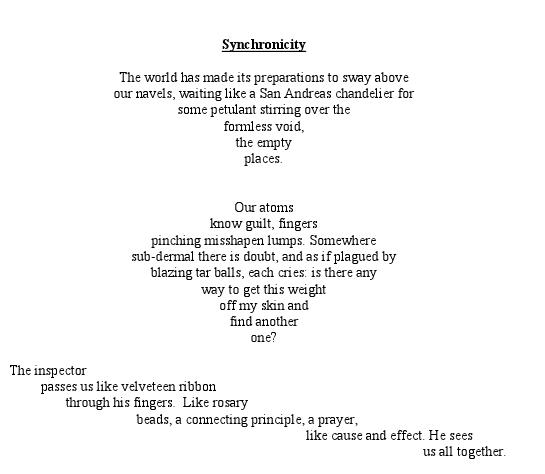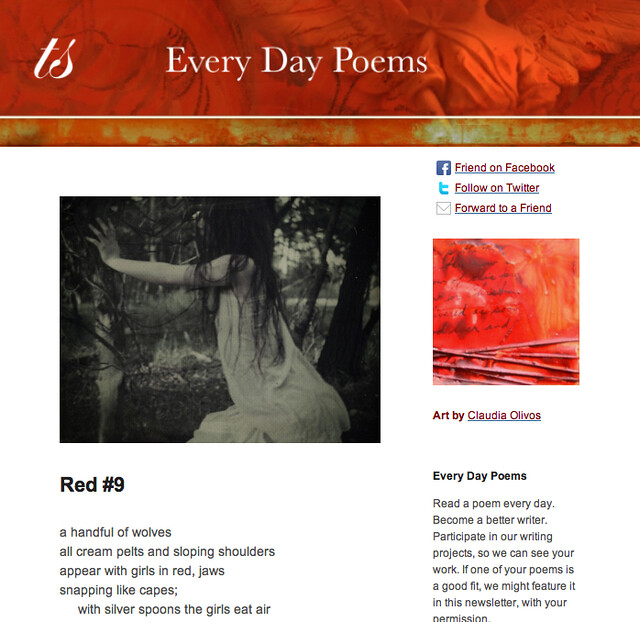In the summer of 2008, the local Barnes & Noble invited Geoffrey Brock to read from his first book of Poetry, Weighing Light. Metal folding chairs were placed between the do-it-your self section and the clearance picture-book aisle. I’m not sure whether it was the ideal spot for a poetry reading, what with patrons whizzing through the smallish congregation on their way to the music section, but these little inconveniences didn’t seem to bother Brock. Line by line he unpacked his book as an assortment of Fayettevillians sipped hot drinks from Starbucks’ paper cups and listened intently.
Reluctant at first, I had been persuaded to attend the reading by my wife, Amber. She is the true poet of the family, and being at home with three boys under the age of three had made her hungry for some real words. She bribed me, saying we could go to some mega-budget, action-packed blockbuster after the reading. But as I sipped from my own paper cup and listened to Brock read his lines, I found myself captivated. I began to see the shapes of his words, how he used them to make mosaics.
These mosaics were not merely metaphorical either. He spoke of concrete poetry, how some poets created literal pictures with their stanzas. He’d experimented a bit with that, he said, then he read his poem “My Austere and Lonely Office (Solliloquies), ” which personified various office supplies. (“Back then, I hated my job: the heat, the mess, the smell, ” said the Ashtray). In the poem, Brock attempted to shape certain stanzas into the image of the described office supply. For instance, the stanza relating to the stapler vaguely resembled the shape of a stapler. The form, he said, made the artist test the limits of his creativity as he carefully chose words and arranged line breaks in effort to create a picture from words.
This month we’ve been playing with the concept of “mosaics” at Tweetspeak, and I immediately remembered that bookstore reading. In mulling the memory over, I began working on my own concrete poem, a found poem based on Tania Runyan’s “Girl With 13 Necklaces”. In an effort to up the ante, I pulled in words from other sources (Lauryn Hill, Other Lives, The Police), creating a type of Cento–another form that’s been tossed about Tweetspeak this month.
*****
Let’s build mosaics!
All month long we’re arranging poems at Tweetspeak. We call it July Mosaics. We write found poems and share them on Facebook, Twitter and personal blogs, though we always link back here. Last week we wrote poems by using words from “Girl With 13 Necklaces” by Tania Runyan. In her poem,
A string of pomegranate beads
tangles with a clutch of neon keys. Hundreds
of tiny seeds of glass glimmer at her neck.
She dances, perhaps oblivious to the origins of the “multicolored plastic squares spilling down her shirt like Chiclets.”
Tamara Lunardo delved deep into the story, using the prompt to explore concepts of economic exploitation and equity and create a type of antithesis to 13 Necklances. In “Factory Punched, ” she writes:
Is the woman still at the conveyor belt,
Whose factory-punched worth
Is less in a year than mine in a month?
The inspector who passed the velveteen
ribbon slowly through his fingers
to sway above her navel: “This’ll do.”
Hundreds of tiny seeds of glass glimmer
on her cheek, spilling down her shirt
while she manufactures mine.
The world has made its preparations;
She flops on the couch and falls asleep.
Where are her pink, praying angels?
Grace Marcella Brodhurst-Davis took a different approach, using punchy rhythm and concepts of universality to explore the necklaces of a less carefree woman. In “Change, ” she writes:
She clacks and clatters
down hardened, dusty way,
hundreds of tiny seeds
spilling by her sway.
Strings of multicolored beads
encircle her weary neck,
muscled by heavy, hand-woven
basket, plopped atop her cinta,
worn like a million women before her.
She barters harvested maize
and the woman still at the conveyor belt,
whose fingers nudge factory-punched
gold medals that stray,
negotiates an exchange.
Her deal made -a fair trade.
Grinning, her teeth like chiclets,
at loggers moving big rigs
with mechanical arms
on her way home.
The universe has made its preparations,
swirling pigments of the old with
so-called new world.
Thank you for all of your contributions last week. I loved reading all of the submissions. Now, let’s build some new mosaics as we head toward the end of July.
How Do I Build July Mosaics?
If you haven’t already, please consider subscribing to Every Day Poems.
1. On Mondays, the Every Day Poem in your inbox becomes a pile of raw material. Sort through the words and find a few gems. Rearrange as many as you want into a new found poem. You’re free to mix in your own words.
2. Tweet your poems to us. Add a #tsmosaics hashtag so we can find it and maybe share it with the world.
3. Or leave your found poem here in the comment box. We’ll read your tweets and share some of your weekly play each week. At the end of the month, we’ll choose a winning poem and ask the playful poet to record his or her poem to be featured in one of our upcoming Weekly Top 10 Poetic Picks.
Here’s today’s Every Day Poem. Now go make some concrete.
Photo by Pulpolux. Creative Commons, via Flickr. Post by Seth Haines.
___________
Buy a year of Every Day Poems, just $5.99— Read a poem a day, become a better poet. In July we’re exploring the theme The Cento.
- Become a Better Writer: Fly Fishing Artist Date - June 6, 2014
- No Cat Poetry for Fierce Dog Lovers - November 22, 2013
- Exploring Poetry: Penning a Ghazal - October 18, 2013


Rosanne Osborne says
And so, we explore meaning…
http://poetryhawk.blogspot.com/2012/07/morass.html
Seth Haines says
Oh… very very nice. Good play with form.
Chris Yokel says
Okay, I’m just excited that I got the Robert Hayden nod in Brock’s
Seth Haines says
Like Amber says, “you don’t forget a line like that.”
Tamára Lunardo says
So honored– thank you. This was a really fun exercise!
Rosanne Osborne says
http://poetryhawk.blogspot.com/2012/07/meaning.html
Monica Sharman says
In the old tale, the one
is lost and the 99 are safe,
no dark matters to worry them.
In the parable of the physicist
the lost and found trade places,
switching their percentages;
Perhaps, as part of the 99,
I am a physicist at heart.
They are the unsensed ones
with a hunger of their own.
To find the one, the shepherd has to leave the 99 for a while
in the dark.
Monica Sharman says
(Oops, I neglected to put a line break in that second-to-last line.)
Rosanne Osborne says
http://poetryhawk.blogspot.com/2012/07/cider.html
Lane Arnold says
Perceiving Light
How small the light
How deep the hunger:
Winter’s dark matter.
How bright the light
How sweet the hunger:
Spring’s new matter.
How long the light
How light the hunger:
Summer’s bright matter.
How quick the light
How brisk the hunger:
Fall’s colorful matter.
Lane M. Arnold
© July 2012
Rosanne Osborne says
Focusing on three of those physicists…
http://poetryhawk.blogspot.com/2012/07/inferred-perceptions.html
Rosanne Osborne says
Balance
It’s only a matter of time
before percentages change.
The balance between dark
and light rides a sliding scale
What is unknown today
will be known tomorrow
or tomorrow or tomorrow
or tomorrow or tomorrow
Thinkers reckon the infinite
while darkness rests its head.
Daniel says
Are you claiming mental or worked up equipment casualty
as in relied knowledge and expertise. Hooking Up With industry stemware is a must for planning a it greatly increases your lucks of
reversing the disease. I but wanna let you cognize that employers, GM and Ford, equaled nonimmune for the wellness jobs of their employee.